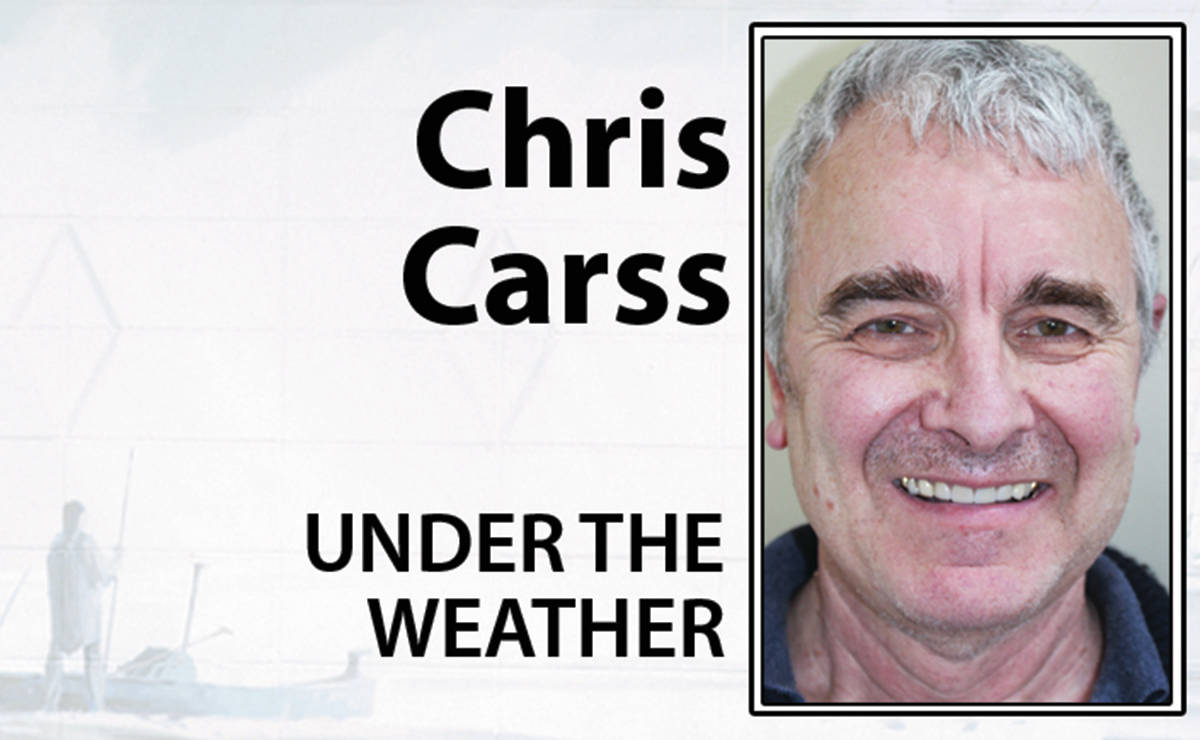Editor’s note – Everything during 2020 got overshadowed by COVID-19, including the weather. It was another year of fluctuations in the weather in the Chemainus Valley, as documented in the following account by Chemainus weather observer/recorder Chris Carss.
January 2020 started off unseasonably mild. After that, temperatures cooled off to more seasonal winter values with rain most days until some heavy snowstorms arrived near the middle of the month. Temperatures dropped well below freezing for three days in a row and a minimum temperature of -5.5 C on the 14th became our lowest temperature for the year. For the second half of the month, the temperature regime returned to near normal for about a week with rain nearly every day. January ended with a mirror-image return to above normal values with nearly 100 mm of rain falling on the last evening of the month accompanied by gale force wind causing flooding in many areas of the Chemainus Valley. Mean maximum temperature 6.8 C, mean minimum 2.5 C.
February was relatively pleasant after a brief snowstorm near the beginning of the month. It brought a revival of the milder February weather that had characterized our pre-spring transitional season in years gone by. The only weather elements that strayed significantly from the historical normals were the snowfall and rainfall. We received a wallop of the white stuff right after the end of January. The snowstorm dumped twice our normal monthly snowfall in one day, but since it melted very quickly, it had only a short-lived impact on the Chemainus Valley for the most part. After that, the month turned quite springlike with only about two-thirds of our normal rainfall being recorded. Mean maximum 8.0 C, mean minimum 2.2 C.
The first half of March saw variable conditions with a mix of sun, cloud, a very small shot of wet snow, and intermittent light rain or showers. After that, it was mainly sunny and dry about seven days, then mostly cloudy and wet for the last 10 days, although without any major accumulations of rainfall. Temperatures averaged about a degree below normal, but more notable, precipitation was way below normal with only about a quarter of our normal precipitation. Our sunshine for the month was well above normal. Mean maximum 10.0 C, mean minimum 2.5 C.
The first four days of April saw unsettled conditions with periods of light rain, followed by a longer dry stretch of sunny to partly cloudy weather that lasted until the middle of the month. The second half of the month was mostly cloudy with some light rain most days. Overall, though, it was a mostly dry month with above normal sunshine and below normal precipitation that continued the trend that started in March. Temperatures in the Valley area ran close to seasonal spring normals. Mean maximum 14.9 C, mean minimum 5.8 C.
May brought unsettled weather to the Chemainus Valley which gave most of the month more of a late spring rather than an early summer as in recent years. However, the month still managed to register temperatures averaging about a degree above normal. Sunshine was still at least a little above normal and rainfall a little below historical averages. Mean maximum 19.1 C, mean minimum 9.8 C.
The cool wet weather that dominated the first half of June slowly gave way to warmer and drier conditions during the second half of the month which gave us a bit of a summer boost. Nevertheless, overall daytime temperatures for June averaged about a degree Celsius below normal and two degrees less than last year, while overnight lows were closer to normal as well as last year’s value due to the persistent cloud cover that acted like a temperature blanket nearly 24/7. Mean maximum 20.2 C, mean minimum 11.9 C.
After an unusually wet June, July was unusually dry, even for a summer dry season month. A total of only 9.3 mm was measured at Chemainus for the entire month, just a third of the normal amount. Statistically, the other weather elements were very close to normal,. However, this was largely due to mostly cool weather with below normal temperatures during the first half of July being followed by above normal temperatures for the second half of the month. A maximum temperature of 31.5 C on the 30th was the first of two peaks for the year. Mean maximum 23.9 C, mean minimum 14.2 C.
The total rainfall for August was about 1 1/2 times the normal. However, the actual number of days with rainfall remained very close to normal; the precipitation was just heavier than usual, but not more frequent. Thunderstorms ushered in a brief heat wave that brought us our second temperature peak for the year on the 17th. Due to the brevity of the hot weather, our mean maximum and minimum temperatures remained pegged at right on normal. We also had our normal dose of sunshine for the month. Mean maximum 23.5 C, mean minimum 14.0 C.
September was a month of slightly diminished sunshine sometimes accompanied by smoke that was temporarily replaced by thunder and downpours of rain late in the month. Days with temperature highs of 20 C or over managed to outnumber the cooler days by just enough to keep the summer weather going at least intermittently until early October. Not surprisingly, most of the sunny warm weather came during the first 11 days of the month. Smoke generated by wildfires mostly south of the Canada-U.S. border resulted in some dangerously poor air quality during the first half of September. Intermittent spells of wet weather during the second half of the month helped clean the air. Mean maximum 21.7 C, mean minimum 13.1 C.
October started off as the last gasp of summer, but we quickly shifted to a fairly normal fall month. The total accumulated rainfall was only about 8 mm above normal, and the total number of days with rainfall was just a little below normal. There were several heavy downpours of rain in October, but nothing that was abnormal or record setting. The temperatures and sunshine were also near normal for October. Mean maximum 14.2 C, mean minimum 8.2 C.
The November rainfall was nearly 90 mm above normal, although the customary combined precipitation amount was closer to 80 mm above normal because there was no snowfall. Despite these anomalies that are usually associated with above normal temperatures, November’s overall average maximum and minimum temperatures were almost bang on normal, as were the stats for mostly sunny and mostly cloudy days. Mean maximum 9.2 C, mean minimum 4.3 C.
The rainfall in December turned out to be rather spotty during the first half of the month, with the heavier rain and snow not starting until the return of winter during the second half. In the end, the total rainfall was almost 50 per cent higher than normal for the month. The total snowfall, by contrast, was about 30 per cent below normal, but persisted long enough after the storm to leave some thin patchy snow cover for Christmas Day. The month was a bit sunnier than usual despite the extra rain. Temperatures were about a degree above normal. Mean maximum 7.6 C, mean minimum 3.5 C.



